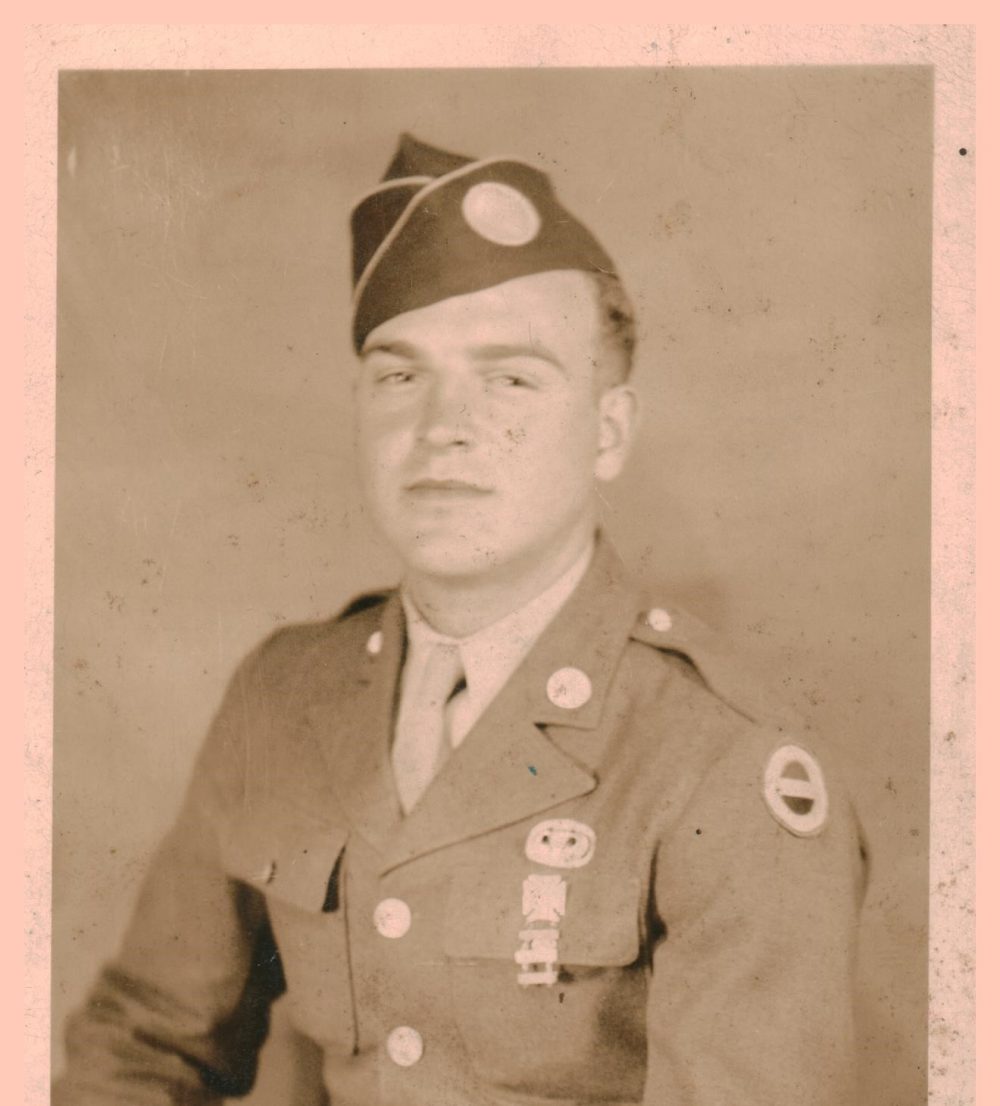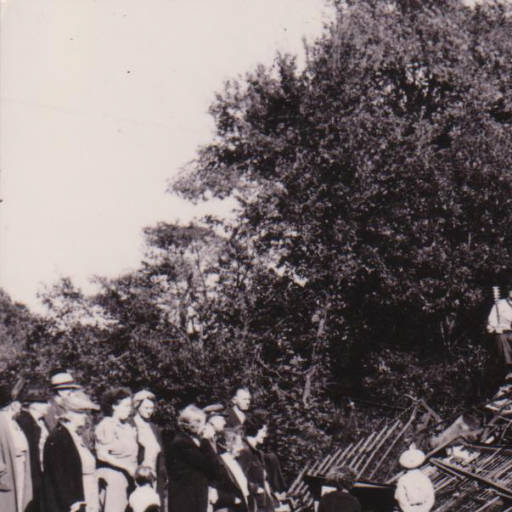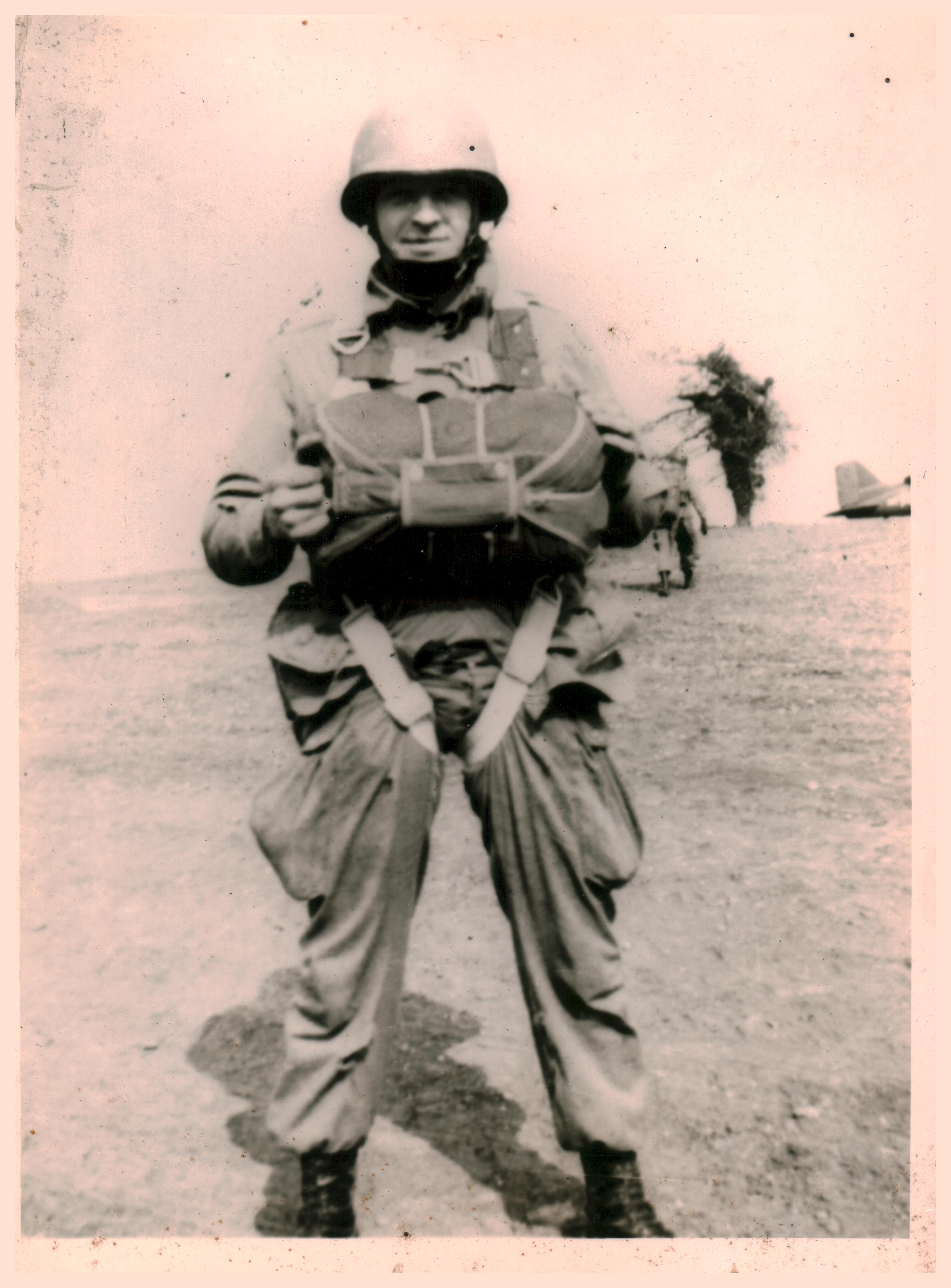Private First Class Joseph Martin Jordan

- Unit: 101st Airborne Division, 506th Parachute Infantry Regiment
- Service Number: 15107661
- Date of Birth: July 25, 1922
- Entered the Military: August 21, 1942
- Date of Death: June 6, 1944
- Hometown: Muncie, Indiana
- Place of Death: Boudainville, France
- Award(s): Purple Heart
- Cemetery: Plot D, Row 24, Grave 37. Normandy American Cemetery, Colleville-sur-Mer, France
Mentored by Mrs. Kristin Rentschler
Columbia City High School
2017-2018
Early Life
On July 21, 1922, Halford and Louvia Jordan of Muncie, Indiana, welcomed their third child, Joseph Martin Jordan, into the world. He was born into a working class family: Halford performed farm work, while Louvia remained at home caring for her children throughout the Great Depression.
Joseph grew up with a large family; six family members besides his parents and him lived in their house in Muncie. Among those were his older brother and sister, as well as his two younger sisters, Barbara and Patricia.
As a teenager, Joseph attended Cowan High School, where his graduating class consisted of 29 students. He enjoyed playing basketball and baseball for the school, as well as other typical teenage activities like fishing and working odd jobs on the farm as well as being a parking lot attendant.
After he graduated from Cowan in 1940, Joseph worked at Delco-Remy, an automobile plant in Muncie, and continued to help out on the family farm. In an act that was not uncommon for the time, Joseph married Phyllis Cleo Lanning, his high school sweetheart, on May 28, 1942, three months before he enlisted in the Army. In March 1943, Joseph’s first and only son was born: Joseph Theodore Jordan. Fortunately, Joseph was able to meet his son before he left for England.

Homefront
America’s entrance into World War II required industrial might to make the switch from commercial products to weapons and equipment for war. Automobile factories began manufacturing jeeps and tanks, and clothing and textile factories began stitching military uniforms for the mass of men enlisting in the U.S. Army.
Indiana became one of the most important states when it came to contributing to the war effort. Seen as a good place for military installations, Indiana went from having two, to having 31 almost overnight. Hoosier factories quickly made the switch to military production: a Plymouth plant in Evansville began producing .45 caliber ammunition instead of automobiles, and went on to produce 96% of all the .45 caliber ammunition used by the armed forces. Boom towns sprang up across Indiana as soldiers and their families moved in order to work at factories and military installations. All in all, Indiana became the eighth most productive state in terms of the war effort.
As with nearly every American town during the war, Muncie quickly switched to producing military goods, and virtually every citizen was affected in some way. Before the war, Muncie was largely a farming community, but as war production ramped up, a working middle class of industrial workers developed and became the majority in town. The Ball Brothers became a household name during World War II for the infamous jars that bore their name. Private First Class Jordan worked at a Delco-Remy automotive plant in Muncie. Delco-Remy was a company that normally produced parts for consumer automobiles, but in December 1941, they switched to 100% war production. They still continued making parts, however these new parts were put to use on jeeps, airplanes, and tanks instead of Studebakers, Hudsons, and Plymouths.

Military Experience
Jordan enlisted in the military early in 1942 at Fort Benjamin Harrison in Indiana. Shortly thereafter, he transferred to Camp Toccoa in Georgia. That summer, Jordan volunteered for the airborne, a new, experimental division that was dangerous and largely unproven in combat. Because the airborne was so dangerous, volunteers were paid an extra $50 a month, this incentive encouraged many men to volunteer. Being a paratrooper was also a sign of elite physical fitness, combat preparedness, and general skill.
Eventually, Easy Company of the 506th Parachute Infantry Regiment, 101st Airborne Division was formed at Camp Toccoa, and Jordan became one of the first members of arguably one of the most storied companies in World War II. Easy Company would go on after D-Day to fight through Normandy, Holland, and Belgium, and would eventually go on to be one of the first American groups to reach Hitler’s Eagles Nest.
Easy Company trained at Camp Toccoa until November 1942, when they completed basic training under First Lieutenant Herbert Sobel. Lieutenant Sobel was Easy Company’s commanding officer, and he was generally hated by every member of the company from the lowest ranking privates to the men ranked directly under him. Sobel believed that his men should fear him, which made him a disciplinarian of the highest degree. He would suspend weekend passes over small issues such as an untucked corner of the bed, or possession of “contraband” that was completely subjective to his own opinion. Life under Sobel was so bad in fact, that some men joked about killing him on accident once they were actually in combat with him.
After Easy Company finished basic training in November, they marched to Atlanta in Easy Company fashion. Some members of Easy had seen a newspaper article that showcased a Japanese unit that marched 100 miles in 72 hours, a world record for distance covered in a land march. The men of Easy Company were all fiercely competitive, and no one would allow an enemy unit to hold the record, so they marched from Camp Toccoa to Atlanta in under 72 hours, breaking the world record the Japanese had recently set.
Easy Company then transferred to Fort Benning, a fort located on the Georgia-Alabama border. It was at Fort Benning that Jordan earned his parachute wings along with the rest of Easy Company. After Fort Benning, Jordan transferred to North Carolina, where he and the rest of Easy Company practiced jumping with weapons and conducting complex military training maneuvers. The last phase of training before departure to Europe took place in the woods of Southern Indiana, Tennessee, and Kentucky.
Jordan crossed the Atlantic in early September 1943 aboard the RMS Samaria, a British troop ship. Once in England, Easy Company was stationed at Aldbourne, where they spent the majority of their time in England for training.
Not long after arriving in England, Jordan fell ill and was forced to have his appendix removed resulting in a lengthy stay at the 2nd General Hospital in Oxford, England, for treatment, and a hiatus from the intense training and rehearsals that were being conducted by Easy Company in preparation for D-Day. Jordan was able to return to training in October, giving him plenty of time to prepare for the invasion of Europe that lay on the horizon.
Easy Company began their “dress rehearsal” for Operation Overlord on April 1, 1944, at Slapton Sands, on the southwest England coast. Slapton Sands was the final step of preparation ahead of Overlord, and while it was not markedly successful, the men felt ready and prepared for any situation that could arise.
In the late hours of June 5, and crossing over into the very early morning of June 6, Jordan boarded a C-47 aircraft with fellow Easy Company men and began the flight across the English Channel to the Norman coast. Under heavy anti-aircraft fire from German guns, Jordan and the men on his plane were dropped in the vicinity of Sainte-Mère-Église. Jordan himself was said to have fallen in Boudainville, which is northwest of Sainte-Mère-Église.


Eulogy
Private First Class Joseph M. Jordan was born on July 25, 1922 in Stony Creek Township, Henry County, Indiana. He was raised in rural Muncie, Indiana. Before enlisting in the Army, Private First Class Jordan married his high school sweetheart, Phyllis Lanning.
Private Jordan enlisted in the Army on August 21, 1942, and subsequently became a part of the 101st Airborne Division, 506th Parachute Infantry Regiment, Easy Company. He spent time training in the U.S. and England preparing for the invasion of Normandy. When the time came, Private First Class Jordan and his men were ready.
Private First Class Jordan was able to make his jump successfully, free himself from his parachute, and establish himself on the ground with some of his buddies behind enemy lines. Shortly thereafter, a member of Easy Company recalled that Private First Class Jordan was killed while helping another paratrooper detach from his chute.
The pain experienced in the wake of Private First Class Jordan’s death is still felt today, in a phone call with his widow, it was obvious that she still lives with the pain she felt all those years ago when her husband made the ultimate sacrifice for his country, while helping his brothers in arms. His legacy has also been carried on by his family, which consists of Air Force officers and Army Rangers. Thanks to them, Private First Class Jordan’s legacy will be remembered for years to come, and his bravery and sacrifice will never have to go unnoticed.
Reflection
As I stood at the Vierville Draw on the Dog Green sector of Omaha Beach, looking down the seawall at the vast expanse of sand that eventually met the water line at low tide, I tried to picture the horizon packed with boats in the early morning fog over 74 years ago.
Later, when I had walked down the beach, I stood in the water at low tide, looking inwards across the hundreds of yards of sand that separated me from the seawall. As I looked in, I tried to put myself in the shoes of an 18-year-old American boy with 80 pounds of equipment loaded onto my back, causing my boots to sink into the soft wet sand. I tried to imagine the rush of adrenaline and the mad dash many of the men on the beach made towards the seawall as German machine gun fire rained down around them, snuffing out the lives of their brothers in arms around them. For me, that moment was when the full scale and chaos of D-Day really set in. Simple words cannot describe what the men on the beaches experienced on June 6, 1944, but my time in Normandy profoundly changed my perspective on life and gave me a new understanding of what the words sacrifice and bravery truly mean.
Our visit to the Normandy American Cemetery to read our eulogies was incredible. The sheer scale and breadth of the cemetery was unbelievable and overwhelming. That, combined with the emotions from the fact that this day was the culmination of half a year spent getting to know a fallen young man, made the entire experience very surreal.
One thought that ran through my mind as we moved from grave to grave and delivered our eulogies that stood out among all the others is that there is so much work left to be done. The Normandy Institute was the most amazing experience of my life, and it has really made me realize that it is our duty to carry on the memory of the heroes that died so long ago for the lives we live today.
Bibliography
Primary Sources
“Camp Toccoa at Currahee.” Video file, 7:27. Youtube. Posted by World War II Foundation, September 18, 2013. www.youtube.com/watch?v=KHos-t9w5_A&t=44s.
Grinstead, Doug. Plant 9 in Muncie, IN. Photograph. Accessed February 27, 2018. www.delcoremyhistory.com/Plant%20Photos/batterypltphotos.htm.
Indiana. Delaware County. 1940 U.S. Census. Digital Images. ancestry.com.
Joseph Jordan, Individual Deceased Personnel File, Department of the Army.
Joseph Jordan, Official Military Personnel File, Department of the Army, RG 319, National Archives and Records Administration – St. Louis.
Joseph Jordan. Indiana, Marriages 1810-2001. Digital Images. ancestry.com.
United States Army. “506th Parachute Infantry Regiment” (1945). World War Regimental Histories. 47.
Secondary Sources
Cox, Hannah. “Shared Sacrifice: Scholars, Soldiers, and World War II.” Ball State University. Accessed February 14, 2018. cms.bsu.edu/academics/libraries/collectionsanddept/archives/collections/stoeckelarchives/exhibits/sharedsacrifice.
Jackson, David D. “Delco Remy in World War II.” The History of the Delco-Remy Division of General Motors. Accessed February 12, 2018. www.delcoremyhistory.com/worldwartwo.htm.
“Joseph Jordan.” American Battle Monuments Commission. Accessed February 8, 2018. abmc.gov/node/410224#.XBAlaHRKjIU.
Levene, David, and Matt Fidler. “Election 2016: The View from Middletown.” The Guardian. Updated October 25, 2016. Accessed March 2, 2018. www.theguardian.com/membership/2016/oct/25/middletown-muncie-factories-photo-essay-midwest.
Madison, James. “Hoosiers at War: An Overview of Indiana During World War II.” Indiana Historical Bureau. Accessed February 13, 2018. www.in.gov/history/4350.htm.
Turner, Lynn W. “Indiana in World War II – A Progress Report.” Indiana Magazine of History, March 1956, 1-2-. Accessed February 14, 2018. scholarworks.iu.edu/journals/index.php/imh/article/view/8380/10473.

